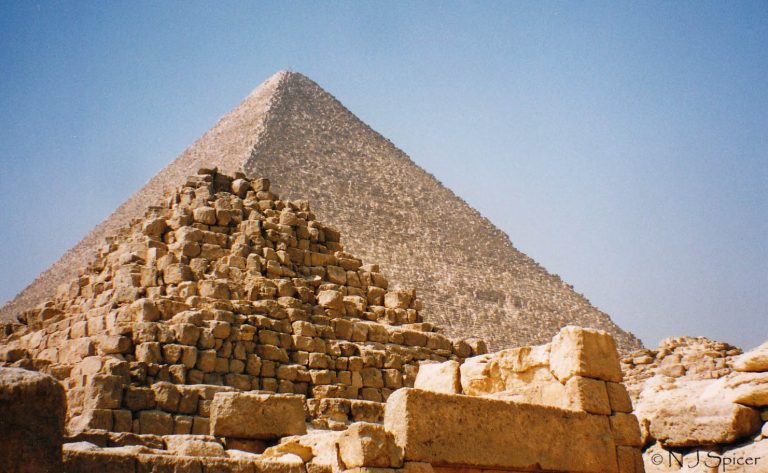History can provide us with many answers, but at the same time it opens up countless questions. As archeologists continue to discover new pieces to the puzzles of the past, we are gradually able to make more sense of the present. Recent findings are believed to offer insight into one of the Seven Wonders of the Ancient World — the Great Pyramids of Giza.
While there are over 100 pyramids in Egypt, the Great Pyramids of Giza are the largest and most mysterious. It is widely believed that all pyramids were constructed by the Ancient Egyptians, yet not everyone agrees. It is certainly difficult to imagine how even the most extraordinary coordination of countless laborers could manage to move millions of sandstone blocks, each weighing around 4,000 lbs.
Some believe that the three Pyramids of Giza — the largest being a colossal monument reaching 480 feet high, were built by an even more ancient, lost civilization that was far more advanced than that of the ancient Egyptians.
Still, scientists believe they have at least discovered a means of transportation for the materials used in these mysterious structures.
The Khufu branch
The Nile River was essential to ancient Egyptian culture, offering a smooth network for trade and travel. Not only did boats ferry people along its waters, it also became a source of irrigation, providing fresh water and fertile soil for farming.
Success
You are now signed up for our newsletter
Success
Check your email to complete sign up
Recently, scientists may have uncovered a forgotten branch of the Nile that could have allowed the Egyptians to transport materials and tools to build these mighty pyramids.
In May 2019, Sheisha Hader, physical geographer at the Aix-Marseille University in France, led a team to explore a dried-up branch of the river, publishing a study on Aug. 29.
According to Hader, the branch was identified by drilling into the streets of Giza, where she and her team found something deep below the surface.
Several excavations revealed ancient grains of pollen, suggesting that aquatic plants once grew there, while also offering insight into climatic conditions of the time.
These findings are taken with a grain of salt by Mark Macklin, a geomorphologist at the University of Lincoln, who said there were limitations on the dates in the sediments found from the drilling. He is cautious not to overestimate their findings. “It would have been good to actually relate it to the sediment and geological based literature which exists in this region,” Macklin said.
If there was indeed a branch of the Nile here, however, it would have provided convenient access to materials for whomever built the last surviving Wonder of the Ancient World.
According to Joseph Manning, professor of classics and history at Yale University, the river was always believed to be how stone was transported from the Tura quarries to the pyramids. However, he assumed that the Egyptians had dug new canals to reach the site.
“I thought they were building canals that connected, but it looks like it’s a natural channel,” Manning said. If people used a natural river branch, it demonstrates the ingenuity of an early civilization to harness this natural resource.
Environmental implications
Since today that river branch is buried underneath urban development, at some point there must have been a significant environmental event that caused the bed to dry up.
Hader’s team deduced that nearby volcanic activity caused the river levels to shift, although Manning pointed out that volcanic activity alone could not be enough.
“Just because you have a volcanic sequence doesn’t necessarily tell you anything about Nile conditions,” he said. Manning mentioned several other factors that could affect water levels, including monsoon patterns in other locations.
READ MORE:
- Sustainable Architecture in China’s Ancient Cave Dwellings: The Yaodong
- The Fujian Tulou – Ancient Sustainable Architecture
- Building with Bamboo: A Sustainable Product With Boundless Utility
Many consider these potential changes in water level to be an important clue to unraveling the mystery.
Christopher Morhange, an expert on geomorphology at Aix-Marseille University, claims that “human imprints on the environment” and “landscape archaeology” play vital roles in the construction of the Pyramids.
Researchers also claim that the fluctuating water levels may have coincided with certain crises — like the pharaohs losing power to governors, famine, and conflict, causing a shift in the construction site away from Giza.
Whether her findings relate to the construction of the Great Pyramids or not, Hader maintains that ancient Egypt was affected by environmental changes, offering a valuable lesson for humanity today.
Hader sees the importance in looking at “the path of their history and how the environment could direct a flourishing empire like the old kingdom,” since their “climate-environmental change being the same reason for which the empire collapsed” could help us understand our own environmental challenges.
As archeologists continue to sort out the facts, we can take valuable lessons from their hypotheses. If the Egyptians used a natural feature rather than carving out their own waterways, it shows great wisdom that we could emulate. Following the course of nature, and gaining without pursuit are universal principles said to bring harmony and happiness.












